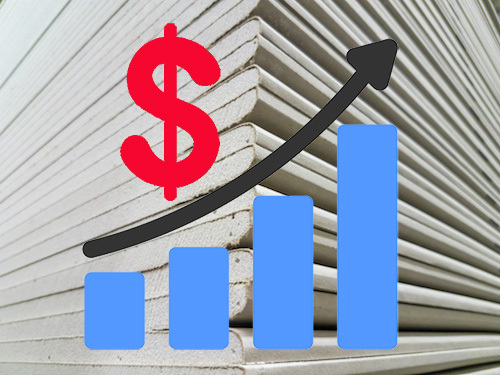 It is important for construction firms and project owners to understand how COVID-19 has impacted and continues to affect the availability and prices of construction materials and supplies. Virus outbreaks and lockdowns have inhibited the manufacturing and transportation of supplies, while a booming residential construction market has increased their demand, leading to a supply squeeze and increasing costs.
It is important for construction firms and project owners to understand how COVID-19 has impacted and continues to affect the availability and prices of construction materials and supplies. Virus outbreaks and lockdowns have inhibited the manufacturing and transportation of supplies, while a booming residential construction market has increased their demand, leading to a supply squeeze and increasing costs.
Following the start of the COVID-19 pandemic in early 2020, we have seen significant supply chain pressure for supplies that we use in our business here at MAREK like gypsum, steel, and lumber.
AGC’s 2021 January PPI report showed that the price of lumber and plywood increased by 50% since January 2020. It has continued to increase over the last couple of months and recently hit an all-time high. We have also seen multiple cost increases for drywall and steel since the second half of last year.
Some of this pressure is related to a decrease in supply directly related to COVID. We have heard of manufacturing facilities having closures because of outbreaks. It doesn’t seem like a lot, but if you have facilities closing for cleaning, sanitizing, or contact tracing on a repeated basis, all of a sudden there’s pressure on supply.
I have also heard stories of businesses having trouble getting their goods to Texas. In some cases, their goods can be stuck in shipping containers on ships off the west coast that wait weeks to be unloaded in California harbors that are operating at limited capacity due to COVID outbreaks and regulations.
Another significant reason for the increase in costs of the supplies we use has been the huge increase in demand for residential construction in Texas since the start of the pandemic. Commercial construction got hit on two sides. One, we've seen commercial projects slow down, and two, the costs of the supplies are increasing due to residential demand.
Commercial and residential construction require different types of drywall, but many are made in the same factories. If the producers have people hounding them all day for the residential grade of drywall, they switch to make more of the residential drywall and less of the commercial drywall.
Everyday people shopping in home improvement stores are also a major portion of the overall demand for drywall. Big block stores like Lowe’s and Home Depot were consuming supplies a lot more as people were stuck at home last year and decided to do weekend projects and fix up the house. Looking at the overall market, it’s not clear how much longer the residential market can keep driving prices higher without a corresponding decrease in demand.
The 2021 Texas winter freeze and power crisis has only increased the demand for drywall following the bursting of hundreds of thousands of pipes.
So, we are experiencing a supply squeeze and additional cost pressures as we’re working in a more constrained environment ourselves. Especially on big projects, if something was already underway or the investment had already been made, we felt the pressure from these supply chain issues immediately. If we already had a contract with fixed numbers in it, then those increased costs landed on us.
For upcoming work, commercial project owners also feel the pressure from this supply squeeze. They understand the price increase is happening, and that it’s going to impact their budget. In some cases, these cost increases can influence whether they choose to go forward with a job. There have also been a lot of projects that were in the pipeline that are now on hold.
Hopefully, as we get closer to normal life later this year, virus-related supply chain problems will resolve, residential and commercial construction demand will rebalance, and the recent increases in supply costs will level out closer to what they were prior to the pandemic.


